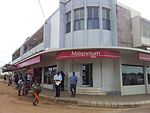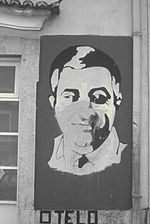Mozambican-Portuguese relations

|
|
|
|
|
| Mozambique | Portugal |
The Mozambican-Portuguese relations describe the intergovernmental relationship between Mozambique and Portugal . Their historical relationships date back to the 16th century when Mozambique became a Portuguese colony . Both countries are founding members of the Community of Portuguese Speaking Countries .
After the end of the Portuguese dictatorship in 1974 and the subsequent independence of Mozambique in 1975, bilateral relations developed largely positively and are now considered excellent. After taking office in March 2016 , Portugal's President Marcelo Rebelo de Sousa traveled to Mozambique at the beginning of May 2016, where he spoke out in favor of even stronger cooperation at all levels and a. met with the three main parties FRELIMO , RENAMO and MDM .
The number of Mozambicans in Portugal is falling. In 2000, there were still 4,660 Mozambicans officially registered in Portugal, by 2008 their number had dropped to 3,347. In 2013, 2,849 Mozambicans were registered in Portugal. The total of their remittances in 2013 amounted to 10.01 million euros.
The number of Portuguese in Mozambique, on the other hand, is increasing again. In 2008, 16,448 Portuguese were registered in Mozambique, by 2011 their number had increased to 19,007. In 2013, 24,191 Portuguese citizens were registered in the consulates in Mozambique, who transferred 7.56 million euros to Portugal.
history
15th century to 1974
The Portuguese Pêro da Covilhã was probably the first European to land in Sofala in 1489 . With the arrival of Vasco da Gama in 1498 began the Portuguese occupation in Mozambique: the Portuguese sailor met a Trading island the local Sheikh Moussa Ben Mbik, from the first name of the island, Ilha de Moçambique ( port. For Island of Mozambique and) later derived from the country of Mozambique.
The São Caetano fortress, built in 1505 at the Sofala trading post, was the first fortified Portuguese base in Mozambique. Afonso de Albuquerque became governor of Portuguese India in 1506 , to which this area was subordinate, and from 1508 had the fortress of São Sebastião built at great expense , which was able to withstand all subsequent attacks from the Arab or Dutch side. In the decades that followed, the Portuguese brought ever larger parts of the previously Arab- dominated trading area under their control and captured more and more parts of the coast. With the subjugation of the Munhumutapa Empire in 1572, the hinterland began to be taken over. Since the hopes of large gold discoveries did not come true, the expeditions into the interior of the country were hardly pushed forward for some time.
The attempts by the Dutch until the beginning of the 19th century to get the area of Mozambique under their control were unsuccessful. The British attempt to take possession of Maputo Bay in 1875 also failed after Patrice de Mac-Mahon awarded Portugal the rights in the arbitration verdict. During the further course of the 19th century and increasing imperialism , Portugal began to expand its colonies. In this context, the colonial power in Mozambique increasingly sought to control the interior of the country, to secure it and to develop and expand it more strongly. Due to a lack of capital of its own, trading companies like the Companhia de Moçambique were founded with international capital .
In 1895 the Portuguese commander Mouzinho de Albuquerque subjugated the kingdom of Gaza, the last independent Bantu kingdom in Mozambique. Watusi King Gungunhana was arrested from Albuquerque and brought to Portugal.
When the other European colonial powers came under international pressure in the years after the Second World War and later released their African possessions into independence, the authoritarian Estado Novo regime in Portugal continued to cling to its historic world empire, making Mozambique one of the newly created overseas provinces of Portugal in 1951 has been.
As in the other African colonies, emancipatory ideas and the desire for decolonization began to develop more strongly in Mozambique and the other Portuguese overseas provinces . One of the most important germ cells for the emerging independence movements was the Casa dos Estudantes do Império , an institution in Lisbon for students from the colonies. Mozambique's first speaker, FRELIMO founding member Marcelino dos Santos, was among them. In addition, some of the barely increasing numbers of Africans with Portuguese civil rights, the Assimilados , who were supposed to provide the elites in Mozambique after the Independence, got involved.
The colonial administration countered the increasingly frequent demands with hidden or open repression. The situation reached its first climax with the massacre in Mueda in 1960, and the independence movements began to organize and later to radicalize. After Angola and Guinea-Bissau , the Portuguese colonial war finally broke out in Mozambique in 1964 .
The Portuguese colonial administration began a comprehensive investment program in Mozambique for the economic development of the colony, which was intended to counteract the aspirations for independence. The most famous project was the ambitious construction of the Cabora Bassa dam , which was built with the support of South Africa and other international investors. From a military point of view, the Portuguese armed forces were initially able to regain the upper hand without, however, achieving lasting pacification.
Since 1974
With the Carnation Revolution on April 25, 1974, a coup by left-wing soldiers presumably led by General Otelo Saraiva de Carvalho, who was born in Mozambique, overthrew the regime in Lisbon. The new leadership then initiated the end of the colonial war and the rapid release of the colonies into independence, sometimes judged to be hasty. The Treaty of Lusaka between the Portuguese government and FRELIMO on September 7, 1974, sealed Mozambique's independence. On June 25, 1975, the independent People's Republic of Mozambique was finally proclaimed and immediately recognized by Portugal. As the first Portuguese Ambassador to Mozambique accredited to Albertino Almeida on 28 June 1975 in Maputo.
Independent Mozambique first tried to address foreign policy supporters to its liberation war, including Bulgaria , GDR , France , Italy , Cuba and the Netherlands . Relations with the Soviet Union , however, turned out to be problematic.
Relations with Portugal intensified again after the end of the People's Republic of Mozambique in 1990 and the subsequent restructuring of the market economy. This was followed by a large number of Portuguese investments and an increasing revitalization of cultural and institutional relations.
In particular, after the significant offshore natural gas discoveries in the Rovuma Basin in 2011 and the estimates of the enormous presumed coal deposits in the province of Tete , relations intensified again. In 2012, for example, Portugal was the second largest investor in Mozambique after the United Arab Emirates and even ahead of the traditionally most important Mozambican economic partner South Africa . Both sides are hoping for major progress, particularly in the areas of telecommunications and information technology , transport infrastructure and banking .
Mozambican-Portuguese relations are now described by both sides as excellent. They can only be improved quantitatively and hardly qualitatively , affirmed Mozambican President Armando Guebuza and Portuguese Foreign Minister Rui Machete at a meeting in Lisbon in 2014. Guebuza only mentioned Portuguese cooperation and Portuguese investments that could be expanded a little further, while Machete agreed with him and named the areas of energy, industry, culture and education as areas of activity that could be further expanded.
diplomacy
Mozambique is represented in Portugal with its own embassy in Lisbon, in Avenida de Berna No. 7. Mozambican consulates general have also been set up in Porto and Lisbon.
Portugal maintains an official representation in the capital of Mozambique with its embassy at number 720 on Avenida Julius Nyerere . There are also Portuguese consulates general in Nampula , Beira and Quelimane .
City friendships
A large number of municipalities in both countries maintain city and community friendships . After the former Portuguese colony Mozambique gained independence in 1975 , the capitals Maputo and Lisbon formed the first Mozambican-Portuguese city friendship in 1982. Today 49 Mozambican-Portuguese partnerships exist or are being initiated (as of 2016), with many cities maintaining partnerships with several locations.
Culture
Institutions
The Instituto Camões is involved with a number of institutions and cooperations in Mozambique. The institute has two cultural and language centers of its own in Beira and the capital, Maputo , and it also has other language centers in Lichinga , Nampula , Quelimane and Xai-Xai .
literature
The Mozambican literature is largely influenced by Portuguese-born Mozambicans. As examples, Mia Couto and José Craveirinha apply.
In 1991, Craveirinha was the only Mozambican (as of 2016) to win the Prémio Camões, the most important literary prize in the Portuguese-speaking world .
In 2009, the equally highly endowed Prémio LeYa went to the Mozambican João Paulo Borges Coelho for his novel O Olho de Hertzog (German: The Eye of Hertzog).
The largest Portuguese publishing houses are also represented in Mozambique, such as the Porto Editora since 2002 with its publisher Plural Editores and the LeYa group with its Mozambican publisher of the same name.

music
Portuguese artists from a wide variety of fields come from Mozambique, including the well-known singers Amélia Muge and Mariza , who is now considered the most internationally known Fado singer.
During colonial times, Portuguese musicians also traveled through Mozambique. The Portuguese beat band Quinteto Académico, for example, stayed for a few months in Mozambique in 1968, where they a. a. performed in the Hotel Polana together with the world-famous Amália Rodrigues .
The Portuguese tenor Lomelino Silva , who was world-famous in the 1920s and 1930s, was honored on June 28, 2001 in his hometown of Funchal by the Portuguese tenor Carlos Guilherme , who sang the same repertoire in his recital that Silva performed in his concert on December 29, 1932 in Teatro Varietá in the Mozambican capital.
Movie
At the Mozambican filmmaking Portuguese filmmakers were involved since the beginning. Since the 1990s, there has been an increasing number of films in Portuguese cinema in Mozambique, for example by director José Carlos de Oliveira or the award-winning films O Gotejar da Luz 2002, The Sleepwalking Land 2007 and Tabu - A Story of Love and Guilt 2012.
economy

The Portuguese Chamber of Commerce AICEP has a branch in Mozambique's capital, Maputo, in Avenida Julius Nyerere No. 720. The bilateral Mozambican-Portuguese Chamber of Commerce ( Câmara de Comércio Portugal Moçambique ) also has an office in Maputo and Lisbon.
In 2015 Portugal exported goods and services worth 598.1 million euros to Mozambique (2014: 480.7 million, 2013: 456.8 million, 2012: 398.1 million, 2011: 304.9 million .), of which 34.8% machines and devices, 13.5% metals, 7.3% food and 7.3% chemical-pharmaceutical products.
In the same period, Mozambique delivered goods and services to Portugal worth 90.2 million euros (2014: 94.7 million, 2013: 125.4 million, 2012: 75.4 million, 2011: 79.5 million .), of which 55.4% agricultural products, 6.2% textiles and 0.4% machines and devices.
Portugal is one of Mozambique's most important investors. In 2012, for example, Portugal was the second largest investor in Mozambique.
As part of an international debt cancellation campaign, Portugal, which itself fell into deep crisis as a result of the euro crisis from 2007, canceled all of its former colony Mozambique's debts in 2008 that the country had incurred since independence from 1975 to 2005. The amount was nearly $ 400 million.
In 2008 Mozambique and Portugal also agreed on closer cooperation in the field of renewable energy . The Cahora Bassa dam , still planned by the colonial power Portugal and one of the largest dams in the world, plays a special role in the country's energy concept. In this context, a change in ownership of the dam was also negotiated. In 2012, the Portuguese state finally sold its last 15% ownership of the dam for around EUR 74 million in equal parts to the Portuguese electricity network operator REN and a Mozambican company.
Sports
Soccer
The top Mozambican football league Moçambola was created under Portuguese colonial administration and was first played as a national championship in 1956. The clubs were often branch clubs of Portuguese clubs, such as the capital club Sporting Clube de Lourenço Marques, today CD Maxaquene, founded in 1920 as a branch club of the Portuguese top club Sporting Clube de Portugal . Portugal's great football legend, Mozambique-born Eusébio (1942–2014), originally came from this club. Eusébio was later eleven times Portuguese football champion with Benfica Lisbon and led Portugal to their best World Cup placement, third place at the 1966 World Cup , where Eusébio was also top scorer. He received the Golden Shoe twice and was named European Footballer of the Year in 1965 , an award that has been named “World Footballer of the Year” since 2007.
With Mário Wilson (1929-2016) came next to Eusébio another football legend of Portugal from Mozambique. As a player, he came from Desportivo de Lourenço Marques to Sporting Lisbon and became Portuguese champions with them in 1951, before becoming the distinctive captain of the Académica de Coimbra team at their most sensational times and coaching them successfully afterwards. As a coach, he was also the national coach and coach of several top teams in the Portuguese Primeira Divisão . In 1976 he was the first Portuguese coach to win the championship with Benfica Lisbon.
Also Mário Coluna (1935-2014) should be mentioned among the great Portuguese football legends of Mozambican origin. Like Wilson, he came to Portugal from Desportivo de Lourenço Marques. He played for Benfica Lisbon from 1954 to 1970, where he was champion several times. He was also the captain of the national team, u. a. in the surprise team of the 1966 World Cup, where he, as the head of the team, was jointly responsible for third place in Portugal together with top scorer Eusébio.
Even before Eusébio, Wilson and Coluna, Matateu (1927-2000) is the first Portuguese top player of Mozambican origin. He was successful both for clubs, in particular for Belenenses Lisbon from 1952 to 1964 , and for the Portuguese national team, for which he scored twelve goals between 1953 and 1960, including one in the 2-0 win against the GDR selection on September 21. June 1959 in East Berlin during the qualification for the EM 1960 .
Mozambican players are still often under contract with Portuguese clubs. They often also acquire Portuguese citizenship and then also play for Portugal's national team, such as B. Abel Xavier , who became the Mozambican national coach in January 2016.
After Mozambique gained independence in 1975, the Mozambican national soccer team and Portugal's national team met for the first time on August 19, 1998 in a friendly on the Portuguese island of São Miguel in the Azores . Mozambique lost 2-1. In the second encounter between the two selections, the friendly match in Johannesburg, South Africa on June 8, 2010, Portugal's team remained victorious, this time 3-0. No further encounter has taken place so far (as of January 2017).
Other
In addition to football, there is a lively exchange in many other sports, such as roller hockey or basketball , where Mozambique has been playing for the Supertaça Luso-Angolana basketball cup since 2012 .
Mozambican athletes are more likely to move to Portugal, where they compete in Portuguese clubs.
Athletes from both countries meet regularly at Jogos da Lusofonia and other sporting events organized by the Community of Portuguese-Speaking Countries (CPLP).
Portuguese of Mozambican origin
A large number of prominent Portuguese were born in Mozambique. The following is a selection sorted chronologically:
- João Garizo do Carmo (* 1917 in Beira ), architect
- Alberto de Lacerda (* 1928 in Maputo ), poet, university professor, art collector, art critic, eccentric
- Júlio Cernadas Pereira (* 1929 in Maputo), soccer player and national coach, several times Portuguese soccer champion as a player and coach
- Orlando da Costa (* 1929 in Maputo), writer and politician, father of the Portuguese Prime Minister António Costa
- Alberto da Costa Pereira (* 1929 in Nacala ), national football goalkeeper
- Acúrsio Carrelo (* 1931 in Maputo), national roller hockey and soccer player
- Eduardo Naya Marques (* 1935 in Maputo), architect
- Otelo Saraiva de Carvalho (* 1936 in Maputo), General of the Carnation Revolution
- António Calvário (* 1938 in Maputo), singer, first representative of Portugal at the Eurovision Song Contest
- Eusébio (* 1942 in Maputo), Portuguese football legend
- Ricardo Chibanga (* 1942 in Maputo), bullfighter
- José Bento (* 1946 in Maputo), Portuguese record badminton player
- Eduardo Pitta (* 1949 in Maputo), writer, columnist and literary critic
- Maria Manuel Leitão Marques (* 1952 in Quelimane ), economist and university professor, minister in the Costa I cabinet
- Amélia Muge (* 1952 in Maputo), musician and composer
- Carlos Queiroz (* 1953 in Nampula ), international soccer coach, 2008–2010 national coach
- António Feio (* 1954 in Maputo), actor
- Rui Abreu (* 1961 in Maputo), Olympic swimmer
- José Castelo Branco (* 1962 in Tete ), art dealer and person of the jet set
- Paulo Teixeira (* 1962 in Maputo), writer
- José Rodrigues dos Santos (* 1964 in Beira), journalist and author, well-known news anchor for the RTP
- Luís de Matos (* 1970 in Maputo), magician
- Rui Águas (* 1972 in Nampula), racing car driver
- Pedro Boese (* 1972 in Beira), German-Portuguese painter
- Abel Xavier (* 1972 in Nampula), national soccer player
- Mariza (* 1973 in Maputo), Fado singer
- Rui Bandeira (* 1973 in Nampula), singer, represented Portugal at the Eurovision Song Contest 1999
- Paulo Fonseca (* 1973 in Nampula), football player and coach
- Diogo Pinto (* 1974 in Nampula), General Secretary of the European Civil Society Movement International
Luís de Matos ( The Magic Circle Prize Winner 2013)
Web links
- Website of the Portuguese Embassy in Mozambique
- Website of the Mozambican Embassy in Portugal
- Website of the Portuguese-Mozambican Chamber of Commerce Câmara de Comércio Portugal Moambique (Portuguese, English)
- Overview of diplomatic relations with Mozambique , website of the Diplomatic Institute in the Ministry of Foreign Affairs of Portugal
Individual evidence
- ↑ a b Relações entre Portugal e Moçambique podem aprofundar-se "em termos quantitativos" - "Relations between Portugal and Mozambique can improve" in quantitative terms " , article of July 2, 2014 in the Portuguese daily Público , accessed on February 5 2017
- ↑ Moçambique recebe Presidente de Portugal - “Mozambique receives the President of Portugal” , article from May 3, 2016 by Deutsche Welle (Mozambique), accessed on February 1, 2017
- ↑ a b Número de moçambicanos em Portugal a diminuir desde 2000 - "Number of Mozambicans in Portugal has been decreasing since 2000" , article from June 29, 2014 in the news portal Notícias ao Minuto , accessed on February 20, 2017
- ↑ a b Official Portuguese statistics on Portuguese-Mozambican migration , accessed on February 20, 2017
- ↑ António Henrique de Oliveira Marques : History of Portugal and the Portuguese Empire (= Kröner's pocket edition . Volume 385). Translated from the Portuguese by Michael von Killisch-Horn. Kröner, Stuttgart 2001, ISBN 3-520-38501-5 , p. 490f.
- ^ Page on diplomatic relations with Mozambique , Diplomatic Institute of the Portuguese Ministry of Foreign Affairs , accessed on May 4, 2019
- ↑ Joseph Hanlon: Mozambique. Revolution in the crossfire . (edition southern Africa 21). Bonn, 1986, pp. 279-280 ISBN 3-921614-25-2
- ↑ Moçambique e Portugal fortificam relações , article of May 2, 2013 in the Portuguese weekly newspaper Expresso , accessed on February 5, 2017
- ↑ List of Mozambican-Portuguese town twinning at the Association of Portuguese Administrative Districts (ANMP), accessed on May 12, 2020
- ↑ Overview of activities in Mozambique , Instituto Camões website, accessed on February 1, 2017
- ^ Supplement to the work show CD edition Train - Integral 1966 - 1968. Valentim de Carvalho 2008.
- ↑ Biography in the comprehensive booklet of the CD Lomelino Silva - O Caruso Português , a retrospective of the recordings from 1926, Tradisom , Vila Verde 2009
- ↑ Overview page on Mozambican-Portuguese relations of the Portuguese Chamber of Commerce AICEP, accessed on February 1, 2017
- ↑ a b Bilateral economic relations between Mozambique and Portugal , Excel file retrieval from the Portuguese Chamber of Commerce AICEP, accessed on January 28, 2017
- ↑ Moçambique e Portugal fortificam relações - “Mozambique and Portugal strengthen relations” , article of May 2, 2013 in the Portuguese weekly Expresso , accessed on February 1, 2017
- ↑ Mozambique gets debt relief from Portugal , article from July 2, 2008 of the news portal Afrik-News , accessed on February 1, 2017
- ↑ Mozambique, Portugal agree to create investment fund , article dated July 2, 2008 by the business news portal Xinhuanet, accessed on February 1, 2017
- ↑ Portugal encaixa 74 milhões com Cahora Bassa - "Portugal takes 74 million with Cahora Bassa" , article of April 9, 2012 in the Portuguese weekly Expresso, accessed on February 1, 2017



















